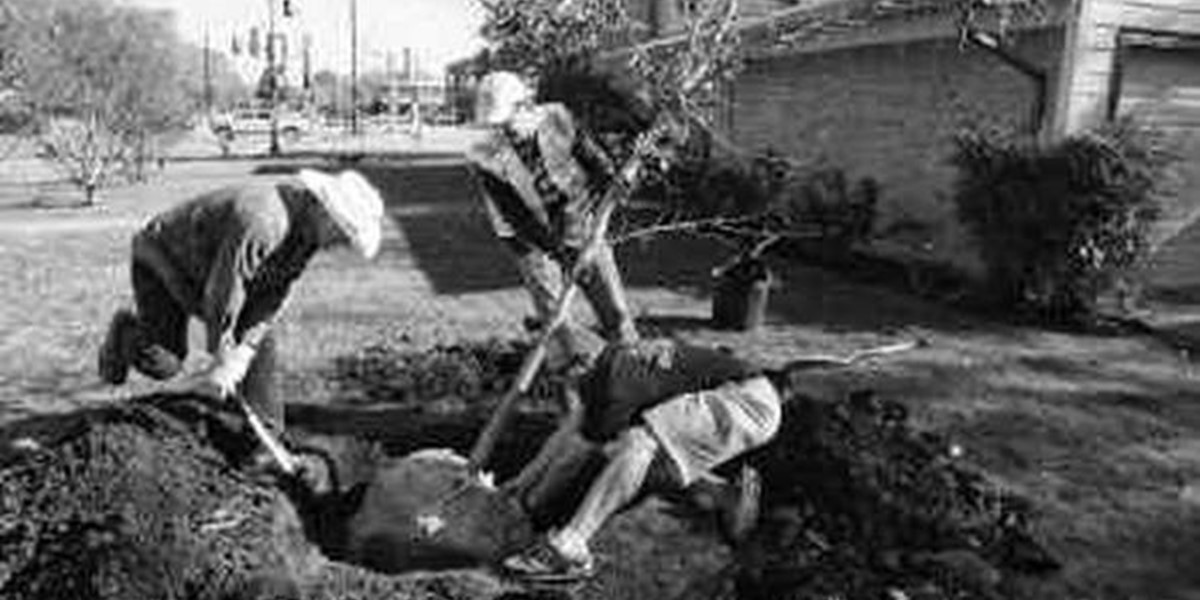

Published December 14, 2010 By ROY APPLETON
Crouching and standing, Bruce Winson fiddled with the new arrival near his White Rock area home.
The live oak now standing some ten feet tall along West Lake Highlands Drive was all right, he said, adding: "Digging the hole last night wasn't much fun."
But you do what you've got to do. And by noon on a recent Saturday, Winson had filled the hole with a gift of sorts from the city.
He and some of his neighbors that day tapped into the city's reforestation program, planting 23 trees - burr oaks, caddo maples, and live oaks - in public right-of-way in front of their homes.
"A lot of people don't realize this is a huge opportunity," said Kurt Kretsinger, Winson's next-door neighbor and a leader of such projects for the city's Urban Forest Advisory Committee.
The reforestation program draws on a city account, now totaling about $2.7 million and growing, to buy trees that private groups such as Winson's Peninsula Neighborhood Association can plant on public property.
When developers clear protected trees from a site, they can plant acceptable replacements nearby, donate trees to the city's Park and Recreation Department, grant the city a conservation easement to protect the selected property or pay into the reforestation fund.
From October 2007 through last May, the fund bought almost 1,700 trees, with another 21 projects involving more than 350 trees in the works this planting season.
"It's a lighter year than usual," said Phil Erwin, the city's chief arborist and director of the reforestation program, which this autumn has added 66 trees in Oak Cliff's Wynnewood North neighborhood, 47 along some of the M streets near Greenville Avenue and 17 in the Belmont Addition of East Dallas.
A success story through the years has been the Winnetka Heights neighborhood in Oak Cliff, where 75 trees were laid in last January, Erwin said.
Besides neighborhood streetside plantings, the free trees can be placed in public medians or parks - with some strings attached.
Recipients can select from 41 city-approved species based on availability. They must handle the planting and agree to water and otherwise maintain the trees in their early years. And they must go through a sometimes-lengthy city approval process.
For example, participants in the city's Adopt-a-Median program can include trees from the reforestation program in their landscape plan, which must be approved by the city forester, Karen Woodard.
And if a review by the city's Public Works and Transportation Department finds no potential safety or visibility problems, the city's Department of Street Services can enter into a MOWmentum agreement with volunteers.
The city now has almost 100 such partnerships, including one with the Turtle Creek Association, which has adopted blocks along Fitzhugh and Lemmon avenues with an investment of almost $90,000.
Park and Recreation officials must approve private plantings in city parks. And the streetside projects go through Erwin, who reviews requests to ensure that proposed sites are appropriate and the trees' prospects are good.
"We're looking at survival over 30 to 50 years," he said. "And when we provide a tree, we need to make sure there's a support network."
Such a network can take time and money, but there's also a public payoff. Trees remove air pollutants, provide temperature-reducing shade and can enhance an area's aesthetics.
And with tight city budgets, public involvement and the reforestation fund can play an important role.
"We could green up a lot of Dallas if people would just take ownership of a little piece of their neighborhood," said Steve Houser, an arborist and past chairman of the city's forest advisory committee. The group's website is DallasTrees.org. In April, Houser directed the planting at Reverchon Park of 48 trees purchased through the fund. The Dallas Mavericks sponsored the event, with Houser's Arborilogical Services taking on the maintenance.
A larger planting involving the Mavericks is planned for next spring around White Rock Lake and in Kiest Park in Oak Cliff, Houser said.
One tree will be planted for each three-point shot scored by the Mavericks this season, all paid for with reforestation dollars. The Dallas office of Pricewaterhouse Coopers will cover the cost of irrigation systems for the plantings, and Houser's company will oversee the maintenance for three years.
"We're talking about planting 250 to 300 trees in one day," Houser said. "It's going to be a really, really neat program."
WHERE TO LEARN MORE
- To learn more about the city's reforestation program and fund, contact Chief Arborist Phil Erwin at 214-948-4117 or philip.erwin@dallascityhall.com.
- For information about the city's MOWmentum program, contact Elizabeth Ponce at 214-670-4491 or elizabeth.ponce@dallascityhall.com.
